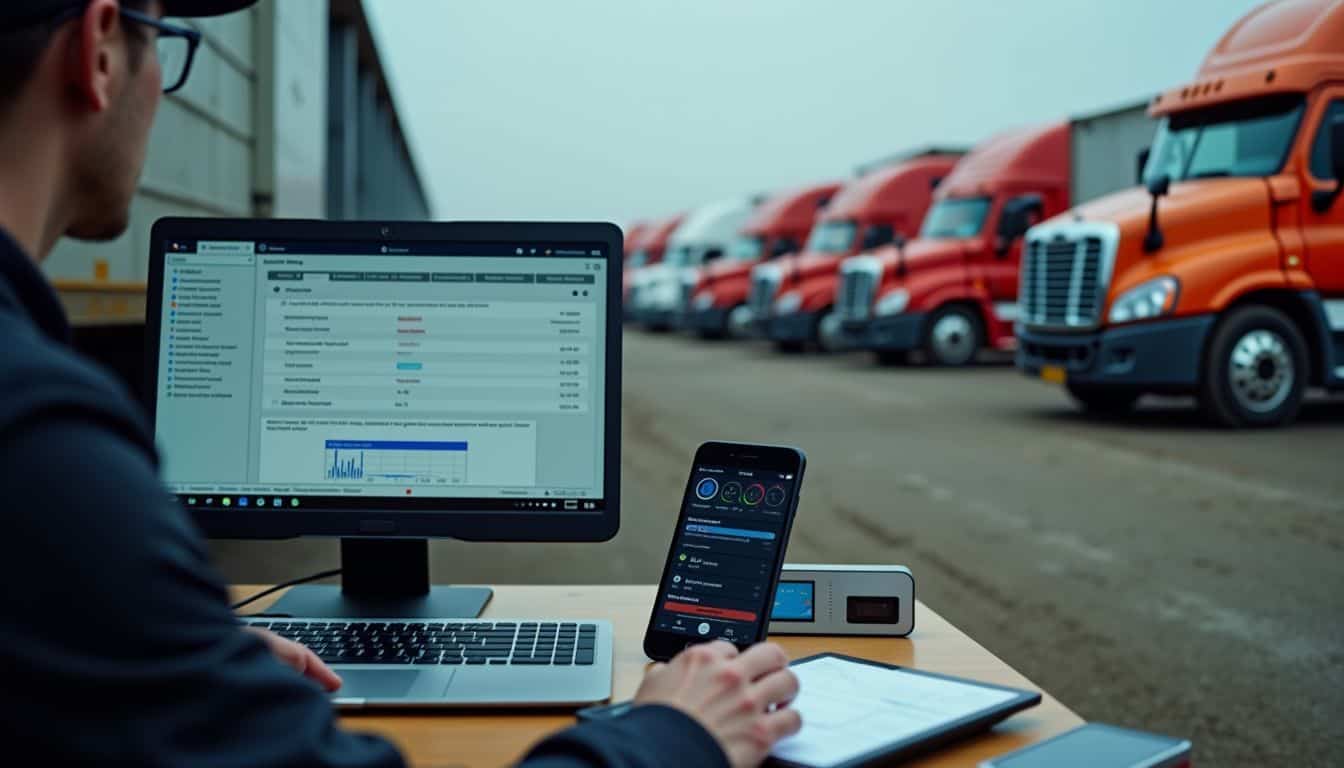Ever wondered how your online order gets from a warehouse to your doorstep? That’s logistics management in action! It’s the behind-the-scenes magic that keeps goods moving smoothly from point A to point B.
In today’s fast-paced world, good logistics is key. It can make or break a business. That’s why more companies are turning to custom logistics software for an edge. These tools help track shipments, optimize routes, and keep customers happy. 3
Ready to unpack the secrets of logistics management? Let’s go!
Key Takeaways
Logistics management coordinates the movement of goods from start to end, using strategies like demand forecasting and just-in-time inventory to optimize stock levels and cut costs.
Smart tech like AI, automation, and GPS tracking boosts efficiency in warehouses and transportation, potentially increasing productivity by over 40% and reducing fuel use by up to 30%.
Good logistics directly impacts customer satisfaction through fast deliveries, accurate tracking, and smooth returns processes, which can make or break a company’s reputation.
Green logistics practices like using electric vehicles, smart packaging, and energy-efficient warehouses can slash carbon emissions by up to 30% while saving money.
Risk management in logistics uses digital tools and math models to spot potential issues early, with over 80% of firms focused on building supply chain resilience.
Table of Contents
Essential Elements of Logistics Management

Logistics management is like a puzzle with many pieces. Each piece plays a key role in making the whole picture work smoothly. Let’s dive into the must-haves that make logistics tick – from smart stock planning to speedy deliveries.
Strategies for Inventory Planning
Inventory planning is a key part of logistics management. It helps businesses maintain optimal stock levels and reduce storage costs. 2 Here’s a look at some important strategies:
- Use demand forecasting: This helps predict future stock needs. Check past sales data, market trends, and seasonal patterns. It’ll help you avoid shortages or excess inventory.
- Implement ABC analysis: Categorize items by importance. ‘A’ items are high-value and need close monitoring. ‘B’ and ‘C’ items require less attention. This approach saves time and effort.
- Set par levels: These are minimum stock amounts for each item. When stock falls below par, it’s time to reorder. It keeps inventory balanced and prevents stockouts.
- Adopt just-in-time (JIT) inventory: Receive stock right when you need it. This reduces storage costs and frees up cash. But it requires close supplier coordination.
- Use safety stock: Maintain extra inventory for unexpected demand increases or supply issues. It’s a buffer against uncertainty. Calculate based on lead times and demand variability.
- Use inventory management software: These tools automate tracking and ordering. They provide real-time data and alerts. The benefits of logistics software include features that fit your business needs. 1
- Practice regular cycle counting: Count a portion of inventory often, instead of once a year. It identifies errors early and keeps records accurate. It’s less disruptive than full counts.
- Improve warehouse layout: Store fast-moving items near shipping areas. Group related items together. A well-organized layout speeds up picking and packing.
Streamlining Inbound and Outbound Logistics
Inbound and outbound logistics are key parts of any supply chain. Smart companies focus on making these processes smooth and fast. 4
- Optimize receiving: Use barcode scanners to quickly log incoming goods. This cuts down on errors and speeds up the process.
- Organize storage: Group similar items together in the warehouse. It makes finding and picking products easier for workers.
- Implement cross-docking: Move goods directly from inbound to outbound without storing them. This saves time and space in the warehouse.
- Use route planning software: Plan the best delivery routes for trucks. It saves fuel and gets products to customers faster.
- Adopt real-time tracking: Use GPS to monitor shipments. Customers love knowing where their orders are at all times.
- Automate order processing: Use software to handle orders from start to finish. It reduces mistakes and speeds up the whole process.
- Train staff well: Well-trained workers make fewer errors. This leads to faster, more accurate logistics operations.
- Partner with reliable carriers: Choose shipping partners carefully. Good carriers ensure timely deliveries and happy customers.
- Use data analytics: Analyze logistics data to find areas for improvement. It helps make smarter decisions about inventory and shipping.
- Implement a Warehouse Management System (WMS): A good WMS improves inventory tracking and speeds up order processing, according to the logistics software company Acropolium. 3
Managing a Fleet for Effective Transportation
Fleet management is crucial for smooth transportation operations. Let’s dive into some key aspects that make it a game-changer:
- Smart vehicle tracking: GPS systems keep tabs on your trucks 24/7. This real-time data helps spot issues fast and boosts overall fleet efficiency. 5
- Route optimization magic: Advanced algorithms crunch numbers to find the best paths. They factor in traffic, delivery windows, and truck capacity for smarter routes.
- Driver safety focus: Telematics tools monitor driving habits and flag risky behaviors. This data can shape training programs and cut down on accidents.
- Fuel efficiency tricks: Software analyzes fuel use patterns across your fleet. It suggests tweaks to save money and reduce your carbon footprint.
- Predictive maintenance wizardry: AI-powered systems predict when vehicles need TLC. This stops surprise breakdowns and keeps your trucks rolling.
- Automated paperwork: Digital solutions zap away the headache of manual record-keeping. E-logs and digital forms make compliance a breeze.
- Performance metrics dashboard: KPIs at your fingertips help spot trends and make smart choices. It’s like a health check-up for your entire fleet.
- Mobile app power: Apps keep drivers and dispatch in sync. Real-time updates and easy communication smooth out bumps in the road. 6
Now, let’s shift gears and look at how logistics pros tackle the tricky world of inventory planning.
Optimizing Warehousing and Storage
Warehousing and storage play a crucial role in logistics management. Smart optimization can boost efficiency and cut costs significantly.
- Space utilization: Stack goods vertically to maximize floor space. Use narrow aisle racking systems for tighter layouts.
- Inventory tracking: Implement RFID tags or barcodes for real-time stock updates. This cuts down on manual counting and reduces errors. 7
- Automated systems: Invest in robotic pickers and conveyors. They work faster and more accurately than humans, 24/7.
- Climate control: Install sensors to monitor temperature and humidity. This keeps goods in top shape, especially for food or electronics.
- Layout design: Place fast-moving items near shipping areas. It speeds up order fulfillment and reduces worker travel time. 8
- Cross-docking: Set up areas to transfer incoming goods directly to outgoing vehicles. This cuts storage time and handling costs.
- Lean principles: Apply just-in-time inventory methods. It reduces holding costs and frees up valuable warehouse space.
- Data analytics: Use software to predict demand patterns. This helps optimize stock levels and prevent overstocking or stockouts.
- Safety measures: Install proper lighting and mark clear pathways. It reduces accidents and improves worker productivity.
- Energy efficiency: Switch to LED lights and motion sensors. They slash electricity bills and shrink your carbon footprint.
Ensuring Efficient Delivery and Order Fulfillment
Optimizing warehousing sets the stage for smooth order fulfillment. Let’s dive into efficient delivery and order fulfillment – the final stretch of logistics magic.
- Speed is key: Fast shipping boosts customer happiness. Use smart routing to cut delivery times and keep buyers smiling.
- Accuracy matters: Double-check orders before they leave. Wrong items = unhappy customers and costly returns.
- Tech it up: Barcode scanners and RFID tags track packages. This cuts errors and speeds up the whole process. 10
- Last-mile logistics: The trickiest part of delivery. Try local pickup spots or drones for hard-to-reach areas. 9
- Real-time updates: Let customers track their orders. It builds trust and cuts down on “Where’s my stuff?” calls.
- Flexible options: Offer same-day, next-day, or scheduled deliveries. Choices make customers feel in control.
- Returns made easy: A smooth return process can turn a negative into a positive. Include return labels with orders.
- Go green: Use eco-friendly packaging. It’s good for the planet and impresses eco-conscious buyers.
- Learn from data: Track delivery times and customer feedback. Use this info to keep getting better.
- Partner up: Work with reliable carriers. A good partnership can make or break your delivery game.
The Role of Logistics Management in Business

Logistics management is a game-changer for businesses. It’s the secret sauce that boosts profits and keeps customers coming back for more.
Boosting Customer Satisfaction through Logistics
Logistics plays a huge role in making customers happy. Fast, on-time deliveries and accurate tracking info can really wow shoppers. It’s not just about getting stuff from A to B. Good logistics means smooth returns, clear communication, and a hassle-free experience.
Happy customers often become loyal fans who keep coming back. 11
Logistics is the backbone of customer satisfaction in e-commerce.
But it’s a two-way street. Poor logistics can tank a company’s reputation fast. Late shipments, damaged goods, or confusing tracking updates? That’s a recipe for angry customers and lost business.
Smart companies focus on nailing their logistics game to keep smiles on faces and cash in their pockets. Next up, let’s dive into how savvy logistics can slash operational costs. 12
Cutting Operational Costs with Smart Logistics
Smart logistics is a game-changer for cutting costs. It’s like having a super-smart robot manage your supply chain. Companies can save big bucks by using AI and automation. These tools make operations run smoother and faster.
They cut down on mistakes that waste time and money. 13
Let’s talk numbers. Smart route planning can slash fuel use by up to 30%. That’s a huge win for the wallet and the planet. Warehouse robots can pick and pack orders twice as fast as humans.
This means fewer workers needed, and less cash spent on labor. It’s not just about saving pennies – it’s about boosting the bottom line in a big way. 8
Enhancing Productivity and Efficiency in Operations
Boosting productivity in logistics is like turbocharging your supply chain. AI tools can supercharge operations by over 40%! 14 That’s huge. Imagine robots zipping around warehouses, putting stuff away and grabbing orders faster than humans ever could.
It’s not sci-fi – it’s happening now.
But wait, there’s more! Smart systems can predict what you’ll need before you even know it. They crunch data to spot trends and avoid hiccups. This crystal ball tech cuts costs and keeps things running smooth.
It’s like having a logistics psychic on your team. For geeks who love efficiency, this stuff is pure gold. 15
Diverse Approaches to Logistics Management

Logistics isn’t a one-size-fits-all game. Different businesses need different tricks up their sleeves to keep things running smoothly – from juggling suppliers to nailing those last-mile deliveries.
Managing Supply Chain Dynamics
Supply chain dynamics are like a complex dance. Many moving parts must work together smoothly. Smart managers use data to predict demand and avoid issues. They can cut forecasting errors by half with AI tools. 17 This helps keep the right amount of stock on hand.
Good supply chain management boosts efficiency and cuts costs. Managers pick the best strategy for their needs. Some go lean to reduce waste. Others stay agile to adapt fast. Many use a mix of both.
The key is to keep goods flowing from suppliers to customers without a hitch. 16
A well-oiled supply chain is the backbone of any successful business.
Optimizing Distribution and Material Handling
Optimizing distribution and material handling is key to a smooth supply chain. It’s all about getting stuff from point A to point B faster and cheaper. Smart companies use cool tech to track items in real-time.
This helps them make quick, smart choices about where things should go. But it’s not just about speed – it’s also about cutting costs and keeping customers happy. 18
Handling materials right can make or break a business. The goal? Move products around with less fuss and more efficiency. Real-time data is a game-changer here. It lets managers spot issues fast and fix them on the fly.
But it’s not all roses… Global supply chains can be tricky to manage. Keeping everything running smoothly takes skill and the right tools. 8 Next up, let’s dive into how customer service fits into the logistics puzzle.
Elevating Customer Service Operations
Great customer service is the secret sauce of logistics. It’s not just about moving stuff from A to B. It’s about making customers happy and keeping them coming back. How? By being clear, quick, and on the ball.
Good service means fewer hiccups and smoother rides for everyone. It’s like having a GPS for your business – it guides you to success. 19
But here’s the kicker: bad service can cost you big time. We’re talking fees, angry clients, and lost deals. Ouch! That’s why smart logistics pros focus on building strong ties with customers.
They solve problems before they happen and keep the lines of communication wide open. It’s all about trust, folks. When you nail that, you’re not just moving goods – you’re moving mountains in your business. 20
Effective Returns Management Strategies
Returns can be a headache, but smart strategies make them a breeze. Geeks, listen up! Reverse logistics is your secret weapon. It’s all about handling returned items like a pro. Got a customer sending back a gadget? No sweat.
With the right system, you’ll process it faster than you can say “reboot.” 21Digital tools are your best friend here. They cut costs and boost accuracy. Imagine scanning a barcode and instantly knowing where that item needs to go. Cool, right? Plus, good returns management keeps customers happy.
Happy customers come back. It’s like leveling up your business game. Next up, let’s talk about how to make your whole supply chain run smoother than a well-oiled machine. 22
Implementing Best Practices in Logistics Management

Logistics pros, listen up! Best practices in this field are like secret weapons. They can turn your supply chain into a well-oiled machine – smooth, fast, and oh-so-efficient.
Automating Core Logistics Operations
Automation is changing the game in logistics. Smart tech is making things faster and cheaper.
- Robots in warehouses: These little helpers zip around, grabbing items off shelves. They cut down on mistakes and speed things up by 200%. 23
- AI for route planning: Clever software figures out the best way to get stuff from A to B. It can slash travel time by 5%, saving gas and money. 23
- Smart inventory systems: No more guessing what’s in stock. These systems know exactly what you have and when to order more. 9
- Drones for delivery: Flying robots can drop off packages in hard-to-reach spots. They’re great for last-mile delivery in busy cities.
- Automated sorting: Machines can sort packages way faster than humans. They use barcodes and cameras to get things where they need to go.
- Self-driving trucks: These big rigs don’t need naps. They can drive non-stop, making long hauls quicker and safer.
- Digital twins: Virtual copies of real-world systems help spot issues before they happen. They’re like crystal balls for your supply chain.
Advancing Routing and Scheduling Techniques
Routing and scheduling have come a long way in logistics. Let’s dive into some game-changing techniques that are revolutionizing the field.
- Real-time data integration: Smart systems now use live traffic updates, weather forecasts, and delivery windows to plot the best routes. This dynamic approach slashes idle time and boosts efficiency. 25
- AI-powered algorithms: These brainy tools crunch numbers faster than you can say “optimization.” They factor in multiple variables to find the perfect balance between speed and cost.
- Time-dependent routing: Traffic isn’t static, so why should routes be? This method adapts to rush hours, construction zones, and other time-based hurdles. 24
- Green routing: It’s not just about speed anymore. New tech helps cut carbon emissions by reducing vehicle idling and finding eco-friendly paths.
- Multi-stop optimization: Gone are the days of simple A to B routes. Today’s systems can juggle dozens of stops, prioritizing urgent deliveries and maximizing vehicle capacity.
- Predictive analytics: By learning from past data, these tools can forecast future issues and suggest proactive solutions. It’s like having a crystal ball for your supply chain!
- Mobile app integration: Drivers now have real-time updates and route changes at their fingertips. This keeps everyone in sync and improves customer service.
- Automated dispatching: Say goodbye to manual scheduling headaches. Smart systems can assign tasks based on driver skills, vehicle types, and delivery priorities.
Adopting Green Logistics Practices
Advancing from routing techniques, we now shift gears to eco-friendly logistics. Green practices in logistics are gaining traction, and for good reason. Here’s a look at how companies are going green in their supply chains:
- Cutting carbon footprints: Firms are using cleaner fuels and electric vehicles. This move slashes CO2 emissions by up to 30% in some cases. 26
- Smart packaging: Companies now opt for reusable or biodegradable materials. This choice reduces waste and saves trees.
- Energy-efficient warehouses: LED lights and solar panels are becoming the norm. These upgrades can cut energy use by half.
- Reverse logistics: Businesses are getting better at handling returns. This process cuts waste and boosts recycling efforts.
- Local sourcing: Buying from nearby suppliers shortens transport routes. It’s a win-win – less fuel use and fresher goods.
- Tech-driven optimization: AI and IoT help plan the best routes. These tools can trim fuel use by up to 15%.
- Green certifications: More firms are going for eco-labels. These badges show customers they care about the planet.
- Circular economy practices: Companies are finding new uses for old products. This approach cuts waste and saves resources. 27
Reinforcing Risk Management and Resilience
Green logistics paves the way for safer supply chains. Now, let’s shift gears to risk management and resilience in logistics.
Risk management is key to keeping supply chains strong. Here’s how companies can beef up their defenses:
- Digital tools are game-changers. They help build tough risk strategies. Companies use software to spot weak links and fix them fast.
- Math models rock the risk world. Over 80% of firms worry about supply chain toughness. Smart math helps them plan for the worst and hope for the best. 28
- Data is king in risk planning. Firms crunch numbers to see what might go wrong. They use this info to make backup plans and stay ahead of trouble.
- Team training boosts readiness. Workers learn to spot risks early. They practice how to act when things go south.
- Supplier checks are a must. Companies dig deep into their partners’ health. They look for signs of trouble before it hits home.
- Cash buffers help weather storms. Firms keep extra money on hand. This helps them stay afloat when supply chains hit rough waters.
- Tech upgrades boost safety. New gadgets track goods better. They help catch problems before they blow up.
- Plan B (and C and D) is crucial. Smart firms have many backup plans. They’re ready to switch gears if one path gets blocked. 29
Overcoming Challenges in Contemporary Logistics Management

Tackling supply chain hiccups, embracing new tech, and going global – logistics managers face a wild ride! But hey, that’s where the fun begins. Wanna know how to crush these challenges? Keep reading!
Tackling Supply Chain Disruptions
Supply chain hiccups can throw a wrench in the works for any business. Big or small, companies face risks like natural disasters, trade wars, or even global pandemics. 30 These issues can ripple through the whole chain, causing major headaches.
It’s no wonder that over 80% of firms worry about keeping their supply chains strong. But here’s the kicker – 60% of companies admit they’re not great at managing these risks. 31 Yikes!
So, what’s a savvy business to do? First off, build a tough-as-nails supply chain. Think of it like a superhero shield – ready to take on whatever comes its way. Next, have a Plan B…
and C and D. It’s all about being ready for anything. For small business shipping, this might mean having backup suppliers or different shipping routes. The key is to stay flexible and think ahead.
By doing this, companies can keep their cool when things get crazy in the supply chain world.
Integrating Cutting-edge Technologies
Moving from tackling supply chain disruptions, let’s explore how tech is changing the game. Cutting-edge tools are reshaping logistics. AI and IoT are leading this charge. They’re not just buzzwords – they’re real game-changers.
Two-thirds of logistics firms are going digital. It’s a big shift. AI makes predictions better. It helps make smarter choices based on data. IoT connects everything, from trucks to warehouses.
This tech boost helps firms work faster and smarter. But there’s a catch. As we plug in more devices, cyber risks go up. In fact, 40% of cyber attacks hit through supply chains. So, while we embrace new tech, we must also beef up our digital defenses.
It’s a balancing act – reaping tech benefits while staying safe. 32 33
Navigating Global Logistics Complexities
Global logistics is a tricky beast. It’s like playing a giant game of chess, but the board keeps changing. Companies face hurdles like trade wars, natural disasters, and political unrest. 34 These can mess up even the best-laid plans. Smart firms know they need to be quick on their feet. They build flexible systems that can roll with the punches.
Tech plays a big role in taming this wild landscape. Tools like IoT devices and AI help track goods across borders. They spot issues before they blow up. 35 But it’s not just about fancy gadgets.
People matter too. Skilled logisticians who understand different cultures are worth their weight in gold. They smooth out bumps in the road and keep things moving. In this complex world, success comes to those who plan ahead and stay alert.
People Also Ask
What’s the big deal about logistics management?
Logistics management is the backbone of any business. It’s like a conductor leading an orchestra. From warehouse systems to transportation planning, it keeps the supply chain humming. Think of it as the secret sauce that makes your favorite burger joint run smoothly.
How does logistics management impact customer experience?
It’s a game-changer! Good logistics management means happy customers. When products arrive on time and in good shape, folks smile. It’s like getting a surprise gift on your birthday. Efficient logistics can boost customer loyalty and polish your brand image.
What’s the scoop on in-house vs. third-party logistics?
It’s a tough call. In-house logistics gives you control, like being the captain of your ship. But third-party providers bring expertise and can save you a bundle. It’s like choosing between cooking at home or eating out. Both have perks, so pick what fits your business best.
How do technology and the Internet of Things (IoT) fit into logistics management?
They’re revolutionizing the field! Smart tech and IoT are like superpowers for logistics managers. They help track cargo, optimize routes, and manage inventories. It’s like having a crystal ball that shows you where everything is and where it’s going.
What role does sustainability play in modern logistics management?
It’s becoming a big deal. Green logistics isn’t just good for the planet; it’s good for business too. Companies are finding ways to cut emissions and reduce waste. It’s like hitting two birds with one stone – saving money and Mother Earth at the same time.
How does logistics management contribute to a company’s competitive advantage?
It’s a secret weapon! Stellar logistics management can set you apart from the pack. It helps cut costs, boost efficiency, and keep customers coming back for more. It’s like having a superfast car in a race – you’ll zoom past the competition and reach the finish line first.
References
^ https://www.researchgate.net/publication/370654003_Logistics_management_in_e-commerce_challenges_and_opportunities_Gestao_logistica_no_e-commerce_desafios_e_oportunidades (2023-05-10)
^ https://www.researchgate.net/publication/376085117_The_Impact_of_Strategic_Inventory_Management_on_Logistics_Organization’s_Performance
^ https://shipsy.io/blogs/strategic-logistics-planning/
^ https://www.shipbob.com/ecommerce-logistics/inbound-outbound-logistics/
^ https://www.netsuite.com/portal/resource/articles/inventory-management/inbound-outbound-logistics.shtml
^ https://celadonsoft.com/best-practices/fleet-management-in-logistics-a-game-changer-for-efficient-operations (2023-05-10)
^ https://gomotive.com/guides/fleet-management/fleet-manager-responsibilities/
^ https://www.sciencedirect.com/science/article/abs/pii/S0360835222004892
^ https://fareye.com/resources/blogs/logistics-operations-optimizing-supply-chain-management (2023-06-29)
^ https://fareye.com/resources/blogs/what-is-logistics-management
^ https://vector-software.com/blog/logistics-management/
^ https://www.researchgate.net/publication/325803696_The_impact_of_the_logistics_management_in_customer_satisfaction (2024-07-16)
^ https://www.ncbi.nlm.nih.gov/pmc/articles/PMC10231832/
^ https://www.researchgate.net/publication/350908579_Operations_management_of_smart_logistics_A_literature_review_and_future_research
^ https://www.logisticsmgmt.com/
^ https://www.scirp.org/journal/paperinformation?paperid=128009
^ https://ieeexplore.ieee.org/iel7/6287639/9668973/09791247.pdf
^ https://online.yu.edu/syms/blog/supply-chain-and-logistics-management
^ https://www.researchgate.net/publication/382680310_Optimizing_supply_chain_and_logistics_management_A_review_of_modern_practices
^ https://www.sentiment.io/how-is-customer-service-related-to-logistics-management-2/ (2024-02-13)
^ https://www.ncbi.nlm.nih.gov/pmc/articles/PMC7563975/
^ https://www.researchgate.net/publication/323635811_A_Strategic_Initiative_for_Successful_Reverse_Logistics_Management_in_Retail_Industry
^ https://ftp.idu.ac.id/wp-content/uploads/ebook/ip/LOGISTIK%20MANAGEMENT/Logistics%20Management%20and%20Strategy%20(%20PDFDrive%20).pdf
^ https://shipsy.io/blogs/logistics-automation-benefits/
^ https://www.sciencedirect.com/science/article/pii/S2192437620300893
^ https://routetitan.com/en/blog/All-About-Logistics-Scheduling
^ https://www.sciencedirect.com/science/article/abs/pii/S0959652622048582
^ https://www.mdpi.com/2079-8954/11/4/198
^ https://www.sciencedirect.com/science/article/pii/S2949863523000304
^ https://link.springer.com/article/10.1007/s10479-024-06126-x
^ https://link.springer.com/article/10.1007/s10479-020-03912-1
^ https://www.ncbi.nlm.nih.gov/pmc/articles/PMC9362030/
^ https://aag-it.com/4-technology-problems-facing-logistics/ (2023-06-30)
^ https://www.researchgate.net/publication/380484636_Logistics_40_A_Comprehensive_Literature_Review_of_Technological_Integration_Challenges_and_Future_Prospects_of_Implementation_of_Industry_40_Technologies (2024-05-12)
^ https://www.sdcexec.com/safety-security/risk-compliance/article/22871946/unique-logistics-navigating-global-logistics-and-supply-chain-to-overcome-obstacles (2023-10-27)



